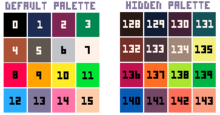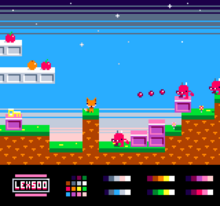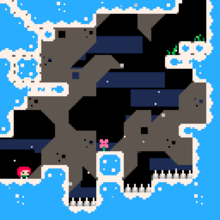PICO-8
 | |
| Developer(s) | Lexaloffle Games |
|---|---|
| Initial release | April 2015 |
| Stable release | 0.2.6b[1]
/ 28 February 2024 |
| Operating system | Windows, Mac OS, Linux |
| Platform | PC, Raspberry Pi, HTML5 (player only) |
| Included with | PocketCHIP[2] |
| Available in | English, Japanese |
| Type | Virtual machine, game engine |
| License | Proprietary |
| Website | lexaloffle |
PICO-8 is a virtual machine and game engine created by Lexaloffle Games. It is a fantasy video game console[3] that mimics the limited graphical and sound capabilities of the old 8-bit systems of the 1980s to encourage creativity and ingenuity in producing games without being overwhelmed with the many possibilities of modern tools and machines. Such limitations also give PICO-8 games a particular look and feel.[4]
Coding on the PICO-8 is accomplished through a Lua-based environment,[5] in which users can create music, sound effects, sprites, maps, and games.
Users are able to export their games as HTML5 web games or upload their creations to Lexaloffle's official BBS where other users are able to play the games in a web browser, and view the source code.[6] PICO-8 games can also be exported as executable programs, which will run on Windows, macOS, or Linux.[7]
Notable games released for the system include the original version of Celeste, which was created in four days as part of a game jam.
On March 14, 2024, Picotron was launched as a fantasy workstation that is conceptually similar to PICO-8. [8]
Capabilities
[edit]The PICO-8 program integrates a Lua code editor, sprite and map creation tools, and an audio sound effect and music editor. The program can load games saved locally on a computer, in the form of text or as specially encoded .png images. The interface also supports a splore mode, where games uploaded to the BBS can be previewed and then played in the PICO-8 program.[9]
PICO-8 games, as well as the program's interface itself, are limited to a 128 × 128 pixel, 16-color display, and a 4-channel audio output.[10]
As of v0.1.11,[11] users may export Pico-8 cartridges as stand-alone executables for Windows, Linux (64 bit), Mac, and Raspberry Pi.
Color palette
[edit]
The PICO-8 palette contains 16 colors. Colors in the palette can be replaced with a different set of colors by indexing a palette update with a color ID larger than 128. These colors are not officially recognized by the creators; however, they are embraced by the community and given unofficial names.[12]
Development
[edit]
Joseph White, who is better known with his nickname Zep, has started working on a BBC BASIC styled BASIC interpreter dubbed LEX500. Joseph later returned to LEX500 while working on another game engine called Voxatron. During development, Joseph switched from BASIC to Lua 2 syntax as the latter is easier to use and more capable as a programming language.[13] He added built-in tools to it such as a music tracker and a map editor, and decided to rename it PICO-8.[14]
Joseph got inspired from older system while setting limitations to PICO-8. The 16-color palette was inspired from Commodore 64, 4-channel trackers from Amiga 500, and overall aesthetics from other 80s hardware such as Apple IIe and Famicom. He coined the term fantasy console to describe systems like PICO-8 that have deliberate limitations to fit a hypothetical hardware.[15]
PICO-BASIC v0.0. got revealed at Pico Pico Cafe on May 9, 2014 by Lexaloffle Games.[16] PICO-8 was released in 2015, respectively, the copyright year still says "2014" starting in the copyright year saying "2014-15" or "2014-2015".
In 2024 for the 10 years of the development of the virtual machine and game engine, the Alpha release of Picotron was launched on March 14, 2024, following the launch of the PICO-8 software version 0.2.6 on February 28, 2024.[17]
Hardware
[edit]As a fantasy console, PICO-8 doesn't have an official hardware that it is based on and all of its limitations are purely emulated. Homebrew computer and hardware hobbyists in general try to fit PICO-8 in low-end devices. PICO-8 has an official image for Raspberry Pi and CHIP (shipped pre-installed in Pocket CHIP),[18] and the PICO-8 community managed to directly run the official software or the games via PICO-8 emulators available in RetroArch on other single board computers.[19][20][21]
While it is not possible to run PICO-8 itself on devices that are not at least i386/amd64 or ARM-64 due to several libraries, people managed to emulate p8 games on various low-cost handheld consoles via open source emulators such as Fake-08 and tac08, which can function even on devices based on 32-bit microcontrollers (most notably ESP32).[22][23]
Adoption
[edit]
The release of PICO-8 attracted the attention of programmers and video game developers who enjoyed the challenge of developing under these limitations, and spurred the development of similar game engines with intentional retro-style limitations. These engines are now commonly dubbed "fantasy consoles", based on a definition of the term on PICO-8's website, and roughly simulate the strict limitations of old game consoles and computers. Among these are TIC-80, which styles itself as a "fantasy computer", and Pixel Vision 8, which allows the user to specify the simulated hardware limitations they wish to develop under.[24] The development of fantasy consoles, as well as the development of games for them, has evolved into its own, almost exclusively hobbyist, sub-community of game development and programming.[25]
PICO-8 gained additional attention in 2018 with the release of Celeste. Originally created as a PICO-8 game for a game jam, Celeste Classic became one of the most popular games on the PICO-8 BBS, prompting the developers to expand the concept into a more expansive, fully realized game. The original PICO-8 version of Celeste is fully playable as an easter egg in the full version of the game.[26]
A low poly cad software named picoCAD is based on PICO-8 and can be used to make models for use both inside and outside of PICO-8, able to export models OBJ/MTL as well as GIF as a rotating model animation.[27][28] Since its release, picoCAD has been used in many 3D PICO-8 games for the creation of models. The software got popularized in the general pixel art and retro game development community due to its unique retro aesthetic.[29][30]
Several remakes and demakes of well-known retro and modern games alike are made on PICO-8. Most notable ones include Terra (Terraria), Poom (Doom), Fuz (Fez), Low Mem Sky (No Man's Sky), and unDUNE II (Dune II).[31][32][33]
PICO-8 has also seen interest among the demoscene, due to its harsh restrictions attracting programmers and musicians who wish to make retro-style demos for the console.[34][35][36]
In March 2024, several PICO-8 games were added as cabinets to Arcade Legend, a VR game where players can play retro arcade games.[37]
See also
[edit]- CHIP-8 - A predecessor to PICO-8 and other fantasy consoles.
References
[edit]- ^ "PICO-8 0.2.6". Lexaloffle. Retrieved 28 February 2024.
- ^ "Next Thing Co. PocketC.H.I.P. Documentation". Archived from the original on 2018-04-20.
- ^ Debock, Arnaud (August 2015). PICO-8 Zine #1. Retrieved November 17, 2016.
- ^ "PICO-8 website". PICO-8 Fantasy Console. Retrieved 12 March 2020.
- ^ Wawro, Alex (May 3, 2016). "PICO-8 'fantasy console' to become an actual handheld console -- sort of". Gamasutra. UBM TechWeb. Archived from the original on November 17, 2016. Retrieved November 17, 2016.
- ^ "PICO-8 BBS". Lexaloffle. Retrieved 20 February 2019.
- ^ "PICO-8 Fantasy Console". www.lexaloffle.com. Retrieved 2020-05-15.
- ^ "Picotron by Lexaloffle". www.lexaloffle.com. Retrieved 2024-07-09.
- ^ "PICO-8 Manual". www.lexaloffle.com. Retrieved 2024-06-03.
- ^ Hossam, Mostafa (August 16, 2016). "Alone in the Dark is still creepy in its brightly-colored remake". Kill Screen. Archived from the original on November 17, 2016. Retrieved November 17, 2016.
- ^ "about 0.1.11 binary exports".
- ^ "Nerdy Guide | PALETTES". nerdyteachers.com. Retrieved 2024-06-03.
- ^ "Voxatron Development Diary 3". www.lexaloffle.com. Retrieved 2024-05-31.
- ^ Walker-Emig, Paul (June 2021). "PICO-8: GAMING'S FANTASY CONSOLE: WE SPEAK TO CREATOR AND COMMUNITY TO FIND OUT HOU A 'CONSOLE' REPLICATING RETRO HARDWARE LIMITATIONS IS GIVING BIRTH TO GREAT GAMES SPARKING CREATIVITY AND PROVIDING A DEVELOPMENT ENVIRONMENT LOVED BY VETERANS AND HOBBYISTS ALIKE". Retro Gamer (221): 64. Retrieved 21 May 2022.
- ^ Altice, Nathan (January 22, 2016). "The Modest Fantasy of the PICO-8". Paste.
- ^ "Picotachi has begun. First of all, the first one is Lexaloffle Games". X post. May 9, 2014.
- ^ "PICO-8 0.2.6". www.lexaloffle.com. Retrieved 2025-01-08.
- ^ "PocketCHIP online documentation". Next Thing Co. Archived from the original on 8 April 2018. Retrieved 19 January 2017.
- ^ "PICO-8 for Raspberry Pi". www.lexaloffle.com. Retrieved 2024-06-03.
- ^ "PICO-8 For PocketCHIP". www.lexaloffle.com. Retrieved 2024-06-03.
- ^ "RetroArch announce the Open Hardware project, plus a new fantasy console core". GamingOnLinux. 2021-02-22. Retrieved 2024-06-03.
- ^ "Simple handheld PICO-8 devices (summer 2021)". www.lexaloffle.com. Retrieved 2024-06-03.
- ^ Labs, peX (2024-06-01). "PeX Labs: Building my own game console for PICO-8". Medium. Retrieved 2024-06-03.
- ^ "TIC80 - A Better Pico8?". 8bitnews.io. Retrieved 2024-06-04.
- ^ Altice, Nathan (January 22, 2016). "The Modest Fantasy of the PICO-8". Paste.
- ^ "FEATURE: Our favourite Easter Eggs on Switch | Switch Player". 2020-04-11. Retrieved 2024-04-19.
- ^ https://johanpeitz.itch.io/picocad [bare URL]
- ^ Shadows (2021-03-05). "picoCAD: "A tiny modeller for tiny models"". 3DVF. Retrieved 2024-06-03.
- ^ "The best low-cost tools for game art". www.gamedeveloper.com. Retrieved 2024-06-03.
- ^ Diaz, Ana (2021-06-29). "Star Wars podracing looks even cooler as pixel art". Polygon. Retrieved 2024-06-03.
- ^ Wilds, Anastasia (2022-09-01). "10 Best Video Game Demakes". ScreenRant. Retrieved 2024-06-04.
- ^ Jody Macgregor (2020-12-13). "Poom is a pixelated 1980s version of Doom you can play right now". PC Gamer. Retrieved 2024-06-04.
- ^ ChippyGaming (2022-02-11). What if Terraria was Created in 1980... Retrieved 2024-06-04 – via YouTube.
- ^ "Puroresu No Seishin, a demo made with Pico-8". Lexaloffle. Retrieved 12 March 2020.
- ^ "Ad Astra". Lexaloffle. Retrieved 12 March 2020.
- ^ "PICOCHAK". Lexaloffle.
- ^ "Arcade Legend Indie Update Brings Pico-8 Retro Cabinets Into VR". UploadVR. 2024-03-07. Retrieved 2024-04-19.
External links
[edit]- Official website
- PICO-8 and the Search for Cosy Design Spaces: a talk by Joseph White, PICO-8's creator
- Top games tagged PICO-8 on itch.io

